Microwave Radiation as a Pre-Treatment for Standard and Innovative Fragmentation Techniques in Concrete Recycling
Abstract
1. Introduction
2. Materials and Methods
2.1. Materials
2.2. Fragmentation Methods
2.3. Experimental Design
2.4. Characterization Methods
2.5. Statistical Analysis
3. Results
3.1. Particle Size Distribution
3.2. Liberation of Aggregates
3.3. Cement Content
4. Discussion
4.1. Liberation of Aggregates
4.2. Cement Content
4.3. Feasibility of Using MWT- and EDF-Technology in Concrete Recycling Systems
5. Conclusions
Author Contributions
Funding
Conflicts of Interest
References
- Gursel, A.P.; Masanet, E.; Horvath, A.; Stadel, A. Life-cycle inventory analysis of concrete production: A critical review. Cem. Concr. Compos. 2014, 51, 38–48. [Google Scholar] [CrossRef]
- Feys, C.; Joseph, M.; Boehme, L.; Zhang, Y. Assessment of Fine Recycled Aggregates. Materials, Technologies and Components for Sustainable Buildings. In Proceedings of the CESB16, Prague, Czech Republic, 22–24 June 2016; pp. 1071–1078. [Google Scholar]
- De Groot, C.; Renate, S.; Van Roo, J.; Dedecker, D.; Smeets, K.; Dierckx, P. Monitoringsysteem Duurzaam Oppervlaktedelfstoffenbeleid, Inzet primaire delfstoffen en alternatieve grondstoffen in Vlaanderen in 2015. In Proceedings of the OVAM, Brusses, Belgium, 3 October 2017. [Google Scholar]
- Ulsen, C.; Tseng, E.; Angulo, S.C.; Landmann, M.; Contessotto, R.; Balbo, J.T.; Kahn, H. Concrete aggregates properties crushed by jaw and impact secondary crushing. J. Mater. Res. Technol. 2018, in press. [Google Scholar] [CrossRef]
- Bravo, M.; De Brito, J.; Pontes, J.; Evangelista, L. Mechanical performance of concrete made with aggregates from construction and demolition waste recycling plants. J. Clean. Prod. 2015, 99, 59–74. [Google Scholar] [CrossRef]
- Marie, I.; Quiasrawi, H. Closed-loop recycling of recycled concrete aggregates. J. Clean. Prod. 2012, 37, 243–248. [Google Scholar] [CrossRef]
- Rakshvir, M.; Barai, S.V. Studies on recycled aggregates-based concrete. Waste Manag. Res. 2006, 24, 225–233. [Google Scholar] [CrossRef] [PubMed]
- Zhao, Z.; Courard, L.; Michel, F.; Remond, S.; Damidot, D. Influence of granular fraction and origin of recycled concrete aggregates on their properties. Eur. J. Environ. Civ. Eng. 2017, 8189, 1–11. [Google Scholar] [CrossRef]
- Lippiatt, N.R.; Bourgeois, F.S. Recycling-Oriented Investigation of Local Porosity Changes in Microwave Heated-Concrete. KONA Powder Part. J. 2014, 31, 247–264. [Google Scholar] [CrossRef]
- Guo, H.; Shi, C.; Guan, X.; Zhu, J.; Ding, Y.; Ling, T.C.; Zhang, H.; Wang, Y. Durability of recycled aggregate concrete—A review. Cem. Concr. Compos. 2014, 89, 251–259. [Google Scholar] [CrossRef]
- Silva, R.S.; De Brito, J.; Dhir, R.K. The influence of the use of recycled aggregates on the compressive strength of concrete: A review. Eur. J. Environ. Civ. Eng. 2015, 19, 825–849. [Google Scholar] [CrossRef]
- Buttress, A.J.; Jones, D.A.; Dodds, C.; Dimitrakis, G.; Campbell, C.J.; Dawson, A.; Kingman, S.W. Understanding the scabbling of concrete using microwave energy. Cem. Concr. Res. 2015, 75, 75–90. [Google Scholar] [CrossRef]
- Akbarnezhad, A.; Ong, K.; Zhang, M.; Tam, C.; Foo, T. Microwave-assisted beneficiation of recycled concrete aggregates. Constr. Build. Mater. 2011, 25, 3469–3479. [Google Scholar] [CrossRef]
- Touzé, S.; Bru, K.; Ménard, Y.; Weh, A.; Von der Weid, F. Electrical fragmentation applied to the recycling of concrete waste—Effect on aggregate liberation. Int. J. Miner. Process. 2017, 158, 68–75. [Google Scholar] [CrossRef]
- Bru, K.; Touzé, S.; Bourgeois, F.; Lippiatt, N.; Ménard, Y. Assessment of a microwave-assisted recycling process for the recovery of high-quality aggregates from concrete waste. Int. J. Miner. Process. 2014, 126, 90–98. [Google Scholar] [CrossRef]
- Ménard, Y.; Bru, K.; Touze, S.; Lemoign, A.; Poirier, J.E.; Ruffie, G.; Bonnaudin, F.; Von Der Weid, F. Innovative process routes for a high-quality concrete recycling. Waste Manag. 2013, 33, 1561–1565. [Google Scholar] [CrossRef] [PubMed]
- Fraj, A.B.; Idir, R. Concrete based on recycled aggregates—Recycling and environmental analysis: A case study of paris’ region. Constr. Build. Mater. 2017, 157, 952–964. [Google Scholar] [CrossRef]
- Uenishi, K.; Yamachi, H.; Yamagami, K.; Sakamoto, R. Dynamic fragmentation of concrete using electric discharge impulses. Constr. Build. Mater. 2014, 67, 170–179. [Google Scholar] [CrossRef]
- (CEN) European Committee for Standardization. EN 206–1:2013, Concrete—Specification, Performance, Production and Conformity; CEN: Brussels, Belgium, 2013. [Google Scholar]
- (CEN) European Committee for Standardization. EN 933-1:2012, Tests for Geometrical Properties of Aggregates—Part 1: Determination of Particle Size Distribution—Sieving Method; CEN: Brussels, Belgium, 2012. [Google Scholar]
- Taylor, H.F.W. Cement Chemistry, 2nd ed.; Thomas Telford Publishing: London, UK, 1997. [Google Scholar]
- Deboucha, W.; Leklou, N.; Khelidj, A.; Oudjit, M.N. Hydration development of mineral additives blended cement using thermogravimetric analysis (TGA): Methodology of calculating the degree of hydration. Constr. Build. Mater. 2017, 146, 687–701. [Google Scholar] [CrossRef]
- Lippiatt, N.; Bourgeois, F. Investigation of microwave-assisted concrete recycling using single-particle testing. Miner. Eng. 2012, 31, 71–81. [Google Scholar] [CrossRef]
- Silva, R.V.; De Brito, J.; Dhir, R.K. Establishing a relationship between modulus of elasticity and compressive strength of recycled aggregate concrete. J. Clean. Prod. 2016, 112, 2171–2186. [Google Scholar] [CrossRef]
- Bru, K.; Touzé, S.; Auger, P.; Dobrusky, S.; Tierrie, J.; Parvaz, D.B. Investigation of lab and pilot scale electric-pulse fragmentation systems for the recycling of ultra-high performance fibre-reinforced concrete. Miner. Eng. 2018, 128, 187–194. [Google Scholar] [CrossRef]
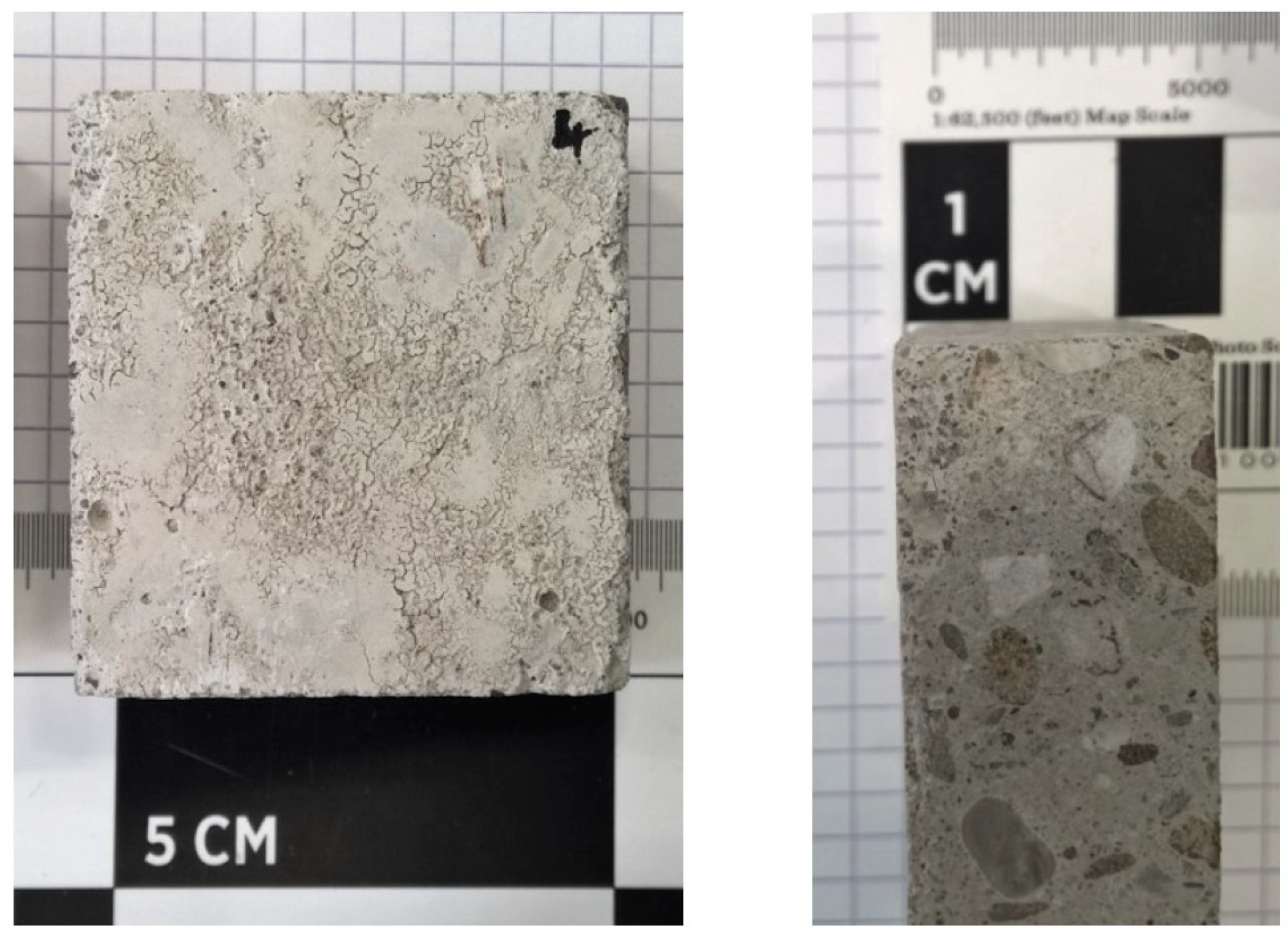
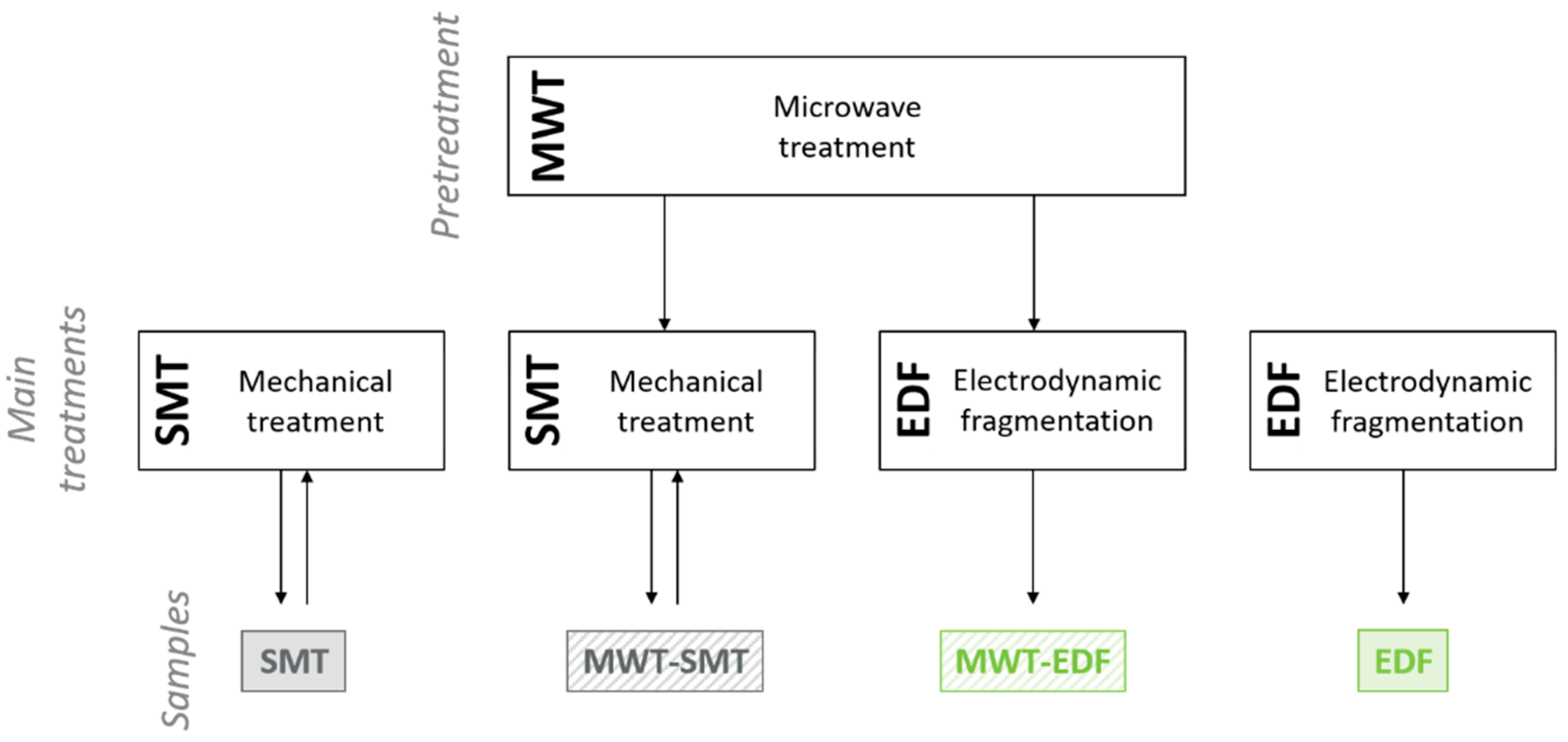
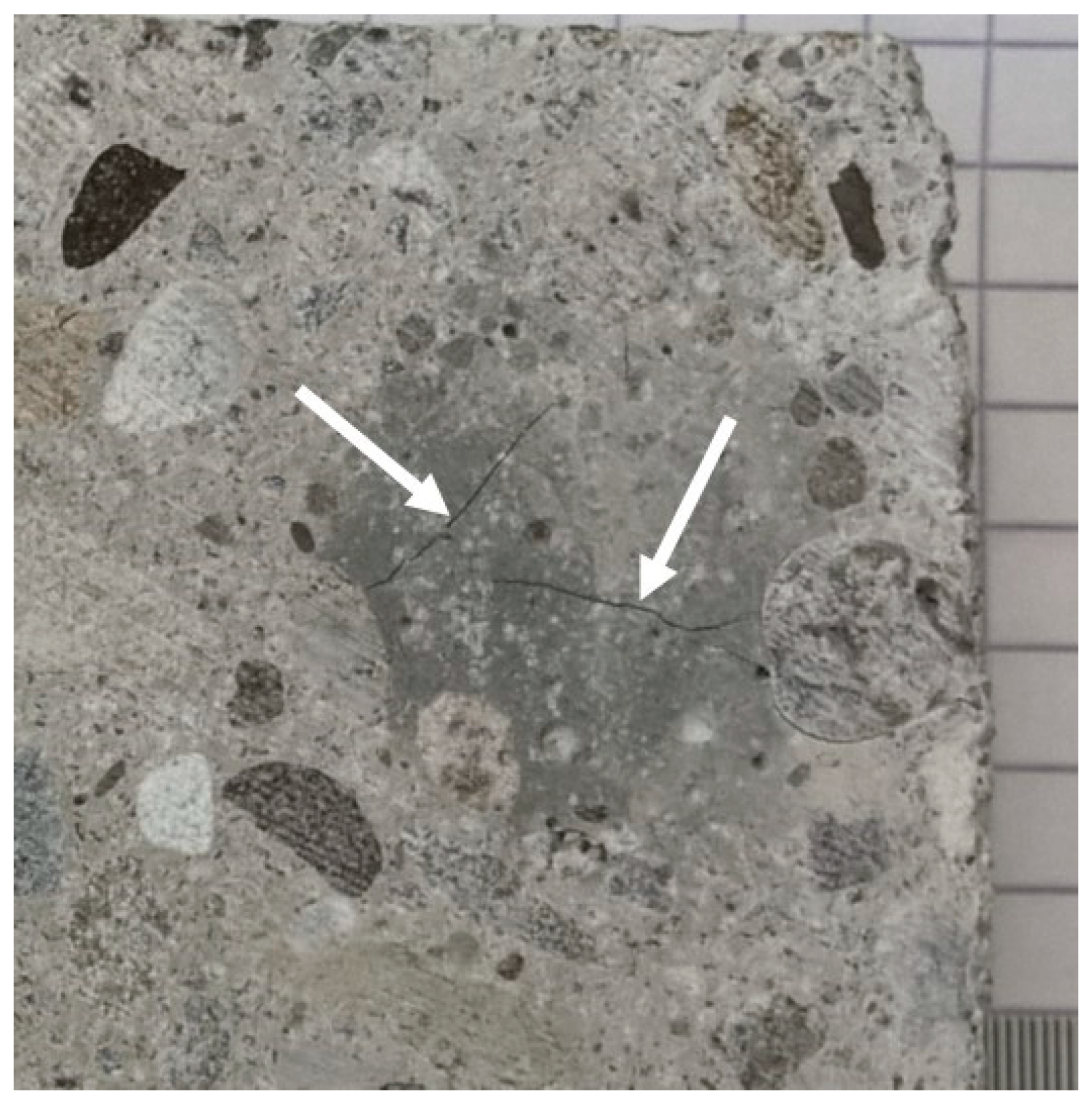
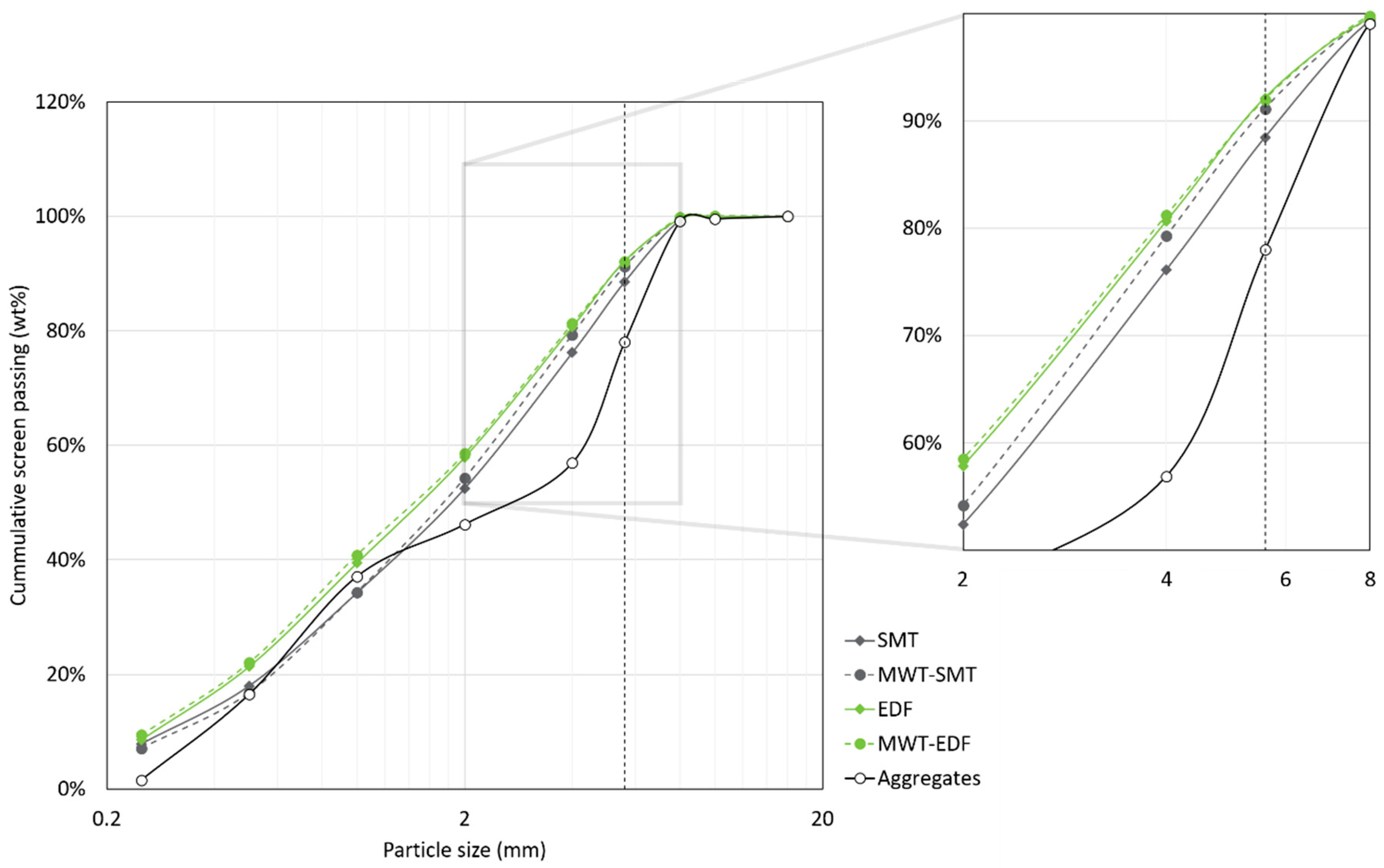

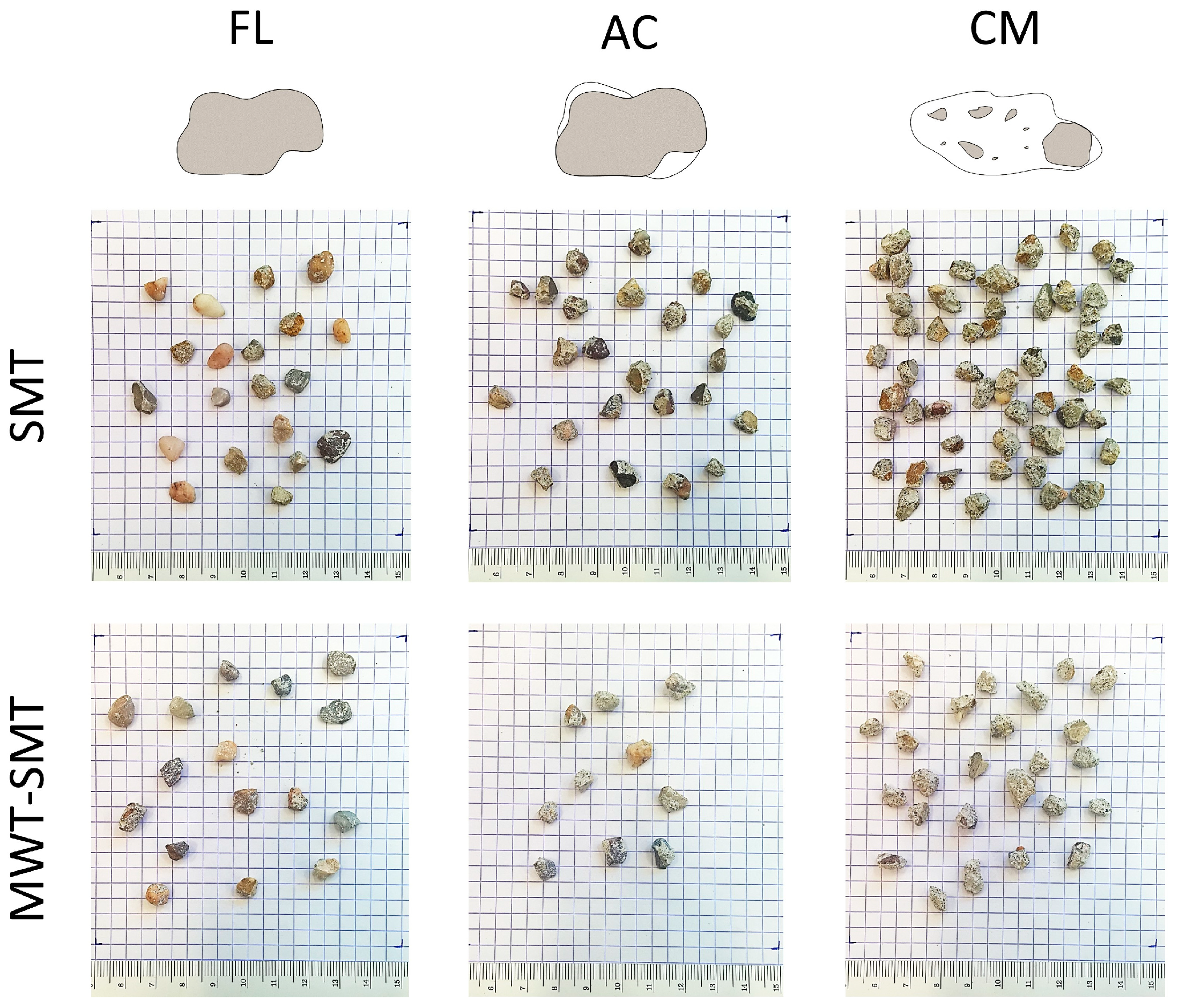
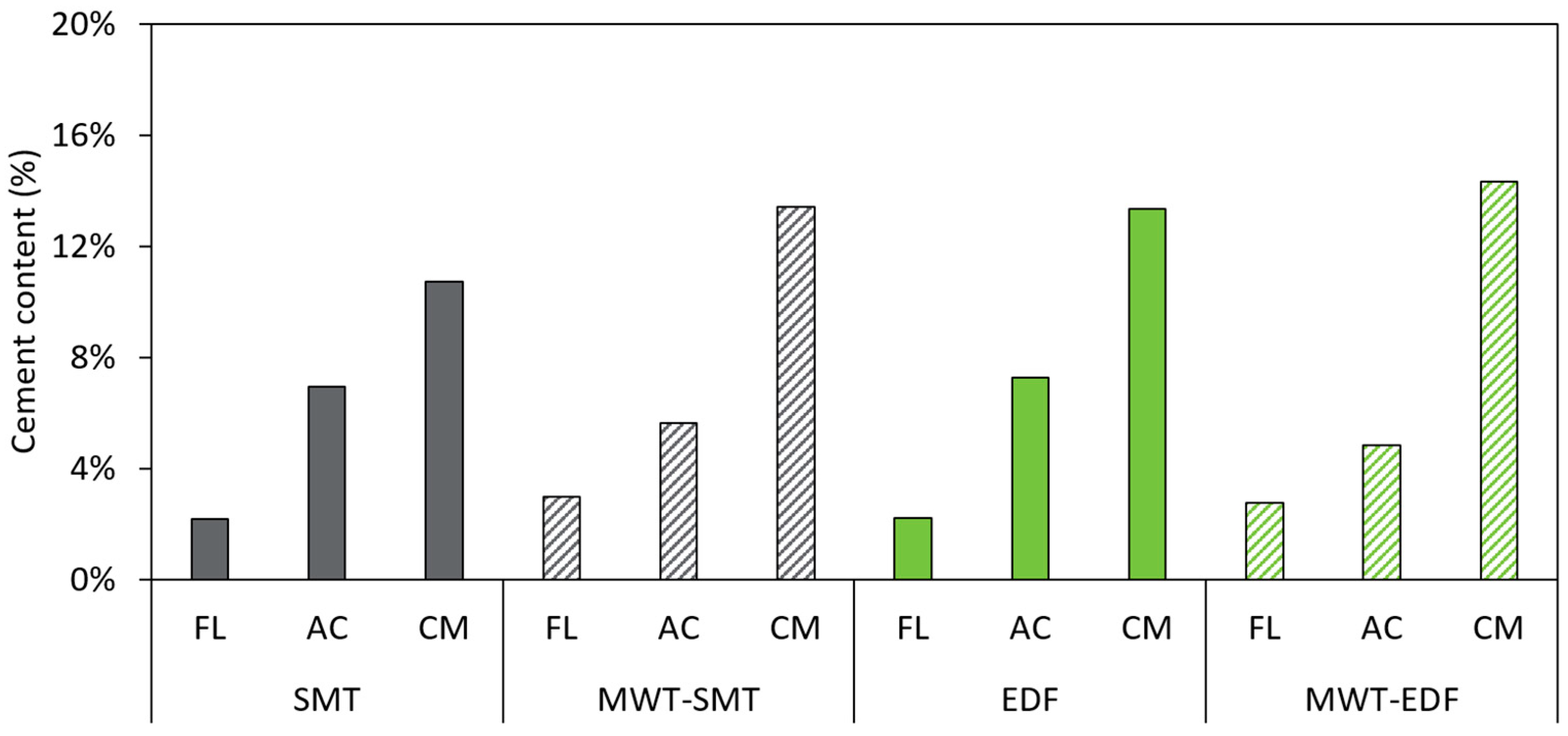

| Particle Class | SMT | MWT-SMT | EDF | MWT-EDF |
|---|---|---|---|---|
| FL | 20% B | 33% b | 77% A | 78% a |
| AC | 23% A | 22% a | 11% B | 7% b |
| CM | 57% A | 45% a | 13% B | 16% b |
| Fraction | FL | AC | CM |
|---|---|---|---|
| >5.6 mm | 2.7% ± 0.4% | 5.9% ± 0.8% | 13.1% ± 2.0% |
© 2019 by the authors. Licensee MDPI, Basel, Switzerland. This article is an open access article distributed under the terms and conditions of the Creative Commons Attribution (CC BY) license (http://creativecommons.org/licenses/by/4.0/).
Share and Cite
Everaert, M.; Stein, R.; Michaux, S.; Goovaerts, V.; Groffils, C.; Delvoie, S.; Zhao, Z.; Snellings, R.; Nielsen, P.; Broos, K. Microwave Radiation as a Pre-Treatment for Standard and Innovative Fragmentation Techniques in Concrete Recycling. Materials 2019, 12, 488. https://doi.org/10.3390/ma12030488
Everaert M, Stein R, Michaux S, Goovaerts V, Groffils C, Delvoie S, Zhao Z, Snellings R, Nielsen P, Broos K. Microwave Radiation as a Pre-Treatment for Standard and Innovative Fragmentation Techniques in Concrete Recycling. Materials. 2019; 12(3):488. https://doi.org/10.3390/ma12030488
Chicago/Turabian StyleEveraert, Maarten, Raphael Stein, Simon Michaux, Vincent Goovaerts, Carlo Groffils, Simon Delvoie, Zengfeng Zhao, Ruben Snellings, Peter Nielsen, and Kris Broos. 2019. "Microwave Radiation as a Pre-Treatment for Standard and Innovative Fragmentation Techniques in Concrete Recycling" Materials 12, no. 3: 488. https://doi.org/10.3390/ma12030488
APA StyleEveraert, M., Stein, R., Michaux, S., Goovaerts, V., Groffils, C., Delvoie, S., Zhao, Z., Snellings, R., Nielsen, P., & Broos, K. (2019). Microwave Radiation as a Pre-Treatment for Standard and Innovative Fragmentation Techniques in Concrete Recycling. Materials, 12(3), 488. https://doi.org/10.3390/ma12030488






